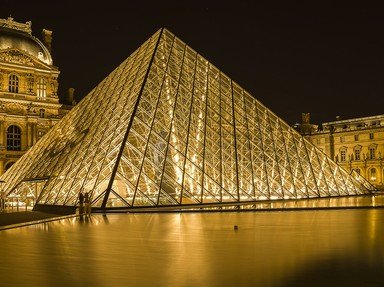Quiz Answer Key and Fun Facts
1. Noted for his extreme attention to detail, Jean Fouquet was one of the most significant painters of the 15th century. He also excelled at what other art form, which requires a lot of precision?
2. 16th-century painter François Clouet owes much of his renown to his depictions of various members of the French royal family. In particular, he created several portraits of what lady, who was briefly Queen Consort of France before becoming a monarch in her own right?
3. Influenced by Caravaggio, Georges de La Tour is probably the best-known of French Baroque painters. Several of his striking candlelight scenes depict what female saint, often mentioned in the New Testament?
4. Almost synonymous with French Rococo, François Boucher is known for his pastoral scenes inspired by classical mythology. The painting in the photo is a portrait of his patroness, the most famous of King Louis XV's mistresses. Who was this lady, whose name might remind you of a hairstyle?
5. A keen supporter of the French Revolution, Jacques-Louis David is famous for his large canvases inspired by Roman history. One of his most iconic paintings, however, is a rather macabre depiction of revolutionary leader Jean-Paul Marat. What happened to him?
6. In the first half of the 19th century, Jean-Auguste-Dominique Ingres became the leading Neoclassical painter. However, some of his work - such as "La Grande Odalisque" in the photo - made him a target of criticism. What caused this painting to be criticized?
7. Eugène Delacroix's quintessentially Romantic paintings were often inspired by the events of his era, as well as literary sources. Many of his works (such as the painting in the photo) were influenced by his trip to what part of the world, in which France was a significant presence?
8. The leader of French Realism, Gustave Courbet painted his most famous work, "A Burial at Ornans", in 1849-50. What made this painting so groundbreaking?
9. The lush, visionary paintings created by Gustave Moreau are among the highest artistic expressions of what major cultural movement of the late 19th century - with which the poets Charles Baudelaire, Paul Verlaine and Arthur Rimbaud were also associated?
10. The creator of this striking jungle scene - a prime example of Naïve art - was known as "Le Douanier" because of his day job as a toll and tax collector. What was his name - shared by a famous 18th-century philosopher?
Source: Author
LadyNym
This quiz was reviewed by FunTrivia editor
looney_tunes before going online.
Any errors found in FunTrivia content are routinely corrected through our feedback system.
